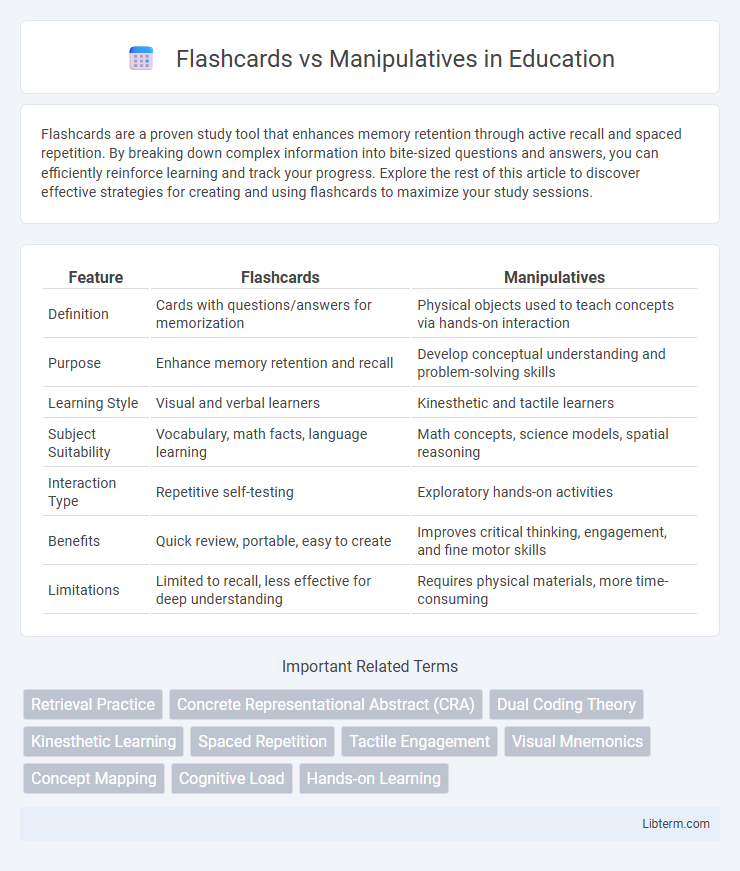Flashcards are a proven study tool that enhances memory retention through active recall and spaced repetition. By breaking down complex information into bite-sized questions and answers, you can efficiently reinforce learning and track your progress. Explore the rest of this article to discover effective strategies for creating and using flashcards to maximize your study sessions.
Table of Comparison
| Feature | Flashcards | Manipulatives |
|---|---|---|
| Definition | Cards with questions/answers for memorization | Physical objects used to teach concepts via hands-on interaction |
| Purpose | Enhance memory retention and recall | Develop conceptual understanding and problem-solving skills |
| Learning Style | Visual and verbal learners | Kinesthetic and tactile learners |
| Subject Suitability | Vocabulary, math facts, language learning | Math concepts, science models, spatial reasoning |
| Interaction Type | Repetitive self-testing | Exploratory hands-on activities |
| Benefits | Quick review, portable, easy to create | Improves critical thinking, engagement, and fine motor skills |
| Limitations | Limited to recall, less effective for deep understanding | Requires physical materials, more time-consuming |
Introduction to Flashcards and Manipulatives
Flashcards serve as visual aids that promote active recall and reinforce memory through repetitive exposure to key facts or vocabulary. Manipulatives are tactile tools, such as blocks or counters, that facilitate hands-on learning and enhance comprehension by allowing learners to physically interact with concepts. Both techniques support diverse learning styles but engage the cognitive process through distinct, complementary methods.
Defining Flashcards: Key Features and Uses
Flashcards are educational tools featuring concise information on one side and corresponding details on the reverse, designed for active recall and spaced repetition to enhance memory retention. Commonly used in language learning, math facts, and test preparation, flashcards facilitate quick self-assessment and reinforcement of key concepts. Their portability and simplicity allow learners to engage in frequent, focused study sessions, optimizing efficient knowledge acquisition and review.
Understanding Manipulatives: What Are They?
Manipulatives are hands-on tools used in education to help students grasp abstract concepts through tangible objects, such as blocks, shapes, or counters. These physical items engage multiple senses, promoting active learning and deeper cognitive processing compared to traditional flashcards, which primarily focus on rote memorization. Using manipulatives supports conceptual understanding in subjects like math and science by allowing learners to explore patterns, relationships, and problem-solving in a concrete manner.
Cognitive Benefits of Flashcards
Flashcards enhance memory retention and retrieval by promoting active recall and spaced repetition, key cognitive processes for long-term learning. They support metacognition by allowing learners to self-assess and adjust study strategies based on performance feedback. Research indicates flashcards are particularly effective for vocabulary acquisition and concept reinforcement, improving overall cognitive efficiency in educational settings.
Hands-On Learning: Advantages of Manipulatives
Manipulatives enhance hands-on learning by providing tactile and visual experiences that reinforce abstract concepts, improving comprehension and retention. Research shows students using manipulatives demonstrate higher engagement and better problem-solving skills, especially in subjects like math and science. These tools cater to diverse learning styles, making lessons more inclusive and effective.
Comparing Flashcards and Manipulatives: Learning Outcomes
Flashcards enhance memory retention and recall by promoting active repetition and visual recognition, making them effective for vocabulary acquisition and factual information. Manipulatives foster deeper conceptual understanding and problem-solving skills through hands-on interaction, ideal for grasping abstract math concepts and spatial relationships. Comparing learning outcomes reveals flashcards excel in memorization speed, while manipulatives improve critical thinking and practical application.
Suitability for Different Learning Styles
Flashcards are ideal for visual and verbal learners, providing concise information that enhances memory through repetition and active recall. Manipulatives cater to kinesthetic and tactile learners by offering hands-on experiences that deepen understanding through physical interaction with concepts. Both tools support diverse learning preferences by engaging multiple senses and reinforcing knowledge effectively.
Situational Effectiveness: When to Use Each Tool
Flashcards are highly effective for memorization and repetitive recall, particularly in language learning or mastering foundational facts. Manipulatives excel in hands-on learning environments, enhancing comprehension of abstract concepts such as math operations or spatial relationships through tactile engagement. Selecting the appropriate tool depends on the learning objective: use flashcards for quick review and retention, and manipulatives for deep understanding and interactive exploration.
Integrating Flashcards and Manipulatives in the Classroom
Integrating flashcards and manipulatives in the classroom enhances multisensory learning by combining visual memory aids with tactile engagement, promoting deeper understanding of concepts such as math operations or vocabulary. Flashcards provide quick recall and reinforcement of facts, while manipulatives allow hands-on exploration, fostering critical thinking and problem-solving skills. Utilizing both tools collaboratively supports diverse learning styles and improves retention through active participation and immediate feedback.
Conclusion: Choosing the Right Educational Tool
Selecting between flashcards and manipulatives depends on the learning objectives and individual student needs. Flashcards excel in reinforcing memory and rapid recall of facts, while manipulatives foster hands-on understanding and conceptual learning. Combining both tools can enhance comprehension and retention, catering to diverse learning styles and educational goals.
Flashcards Infographic

 libterm.com
libterm.com